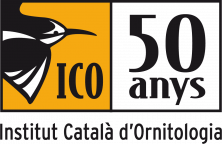Book Review by Anne Weiserbs
DOI: 10.2436/20.8100.01.7
 |
| FULL TEXT / TEXT COMPLET |
This atlas provides an immediate vision to the birds present in Barcelona during the 2012–2016 breeding seasons. No less than 322 volunteers were involved in this project. The presence of a full translation of the Catalan texts into Spanish and English ensures that this work will be appreciated by an even greater public. The layout of the species accounts and the conciseness of the texts facilitate the comparison of the translated texts and illustrations. Moreover, all the maps and tables are translated and included in the summaries, which guarantees easy access to all the information. The ambitious methodology enabled the whole city to be covered at a resolution of 500 x 500 m squares. It is worth highlighting the concerted effort required to complete the fieldwork, and only 10 of the recording squares were left uncovered due to their inaccessibility. The result is a work of remarkable precision, further improved by high-resolution models based on the exact location of observations that generate probability of presence maps at a scale of just 25 x 25 m.
The species accounts contain three sections. The first is devoted to the distribution of each species in terms of its ecology, while the second, besides including a population estimate, describes the population trend of the species over the past decade based on data from the Common Bird Monitoring Program in Barcelona and Catalonia. Finally, this information is complemented by the species’ conservation status in Catalonia in 2012 according to the IUCN categories. This third paragraph also contains an innovative approach that describes species in terms of the ecosystem services they provide, a concept that is not usually broached in the context of a bird atlas. This is due to the authors’ desire to reach a broader public by describing the importance of bird species and of the city’s biodiversity in general.
An original illustration depicts each species in a typical habitat and is accompanied by easily understandable maps. The first one shows the distribution of the observations during the atlas period, with a distinction made between presence and breeding. In the second map, in which only breeding records are given, abundances per square are mapped. For common species, this modelling approach provides an extremely accurate indicator of a species’ probability of presence.
The overall result is a very complete work that is very easy to consult due to its simple layout that provides access to clear well-structured information. It is an important contribution to the knowledge of urban ornithology in terms of both species preservation and the recognition of the role that birds play in establishing close ties between city-dwellers and nature.
Further information about this project here (ICO) and here (Ajuntament de Barcelona)
The species accounts contain three sections. The first is devoted to the distribution of each species in terms of its ecology, while the second, besides including a population estimate, describes the population trend of the species over the past decade based on data from the Common Bird Monitoring Program in Barcelona and Catalonia. Finally, this information is complemented by the species’ conservation status in Catalonia in 2012 according to the IUCN categories. This third paragraph also contains an innovative approach that describes species in terms of the ecosystem services they provide, a concept that is not usually broached in the context of a bird atlas. This is due to the authors’ desire to reach a broader public by describing the importance of bird species and of the city’s biodiversity in general.
An original illustration depicts each species in a typical habitat and is accompanied by easily understandable maps. The first one shows the distribution of the observations during the atlas period, with a distinction made between presence and breeding. In the second map, in which only breeding records are given, abundances per square are mapped. For common species, this modelling approach provides an extremely accurate indicator of a species’ probability of presence.
The overall result is a very complete work that is very easy to consult due to its simple layout that provides access to clear well-structured information. It is an important contribution to the knowledge of urban ornithology in terms of both species preservation and the recognition of the role that birds play in establishing close ties between city-dwellers and nature.
Further information about this project here (ICO) and here (Ajuntament de Barcelona)

.png)












